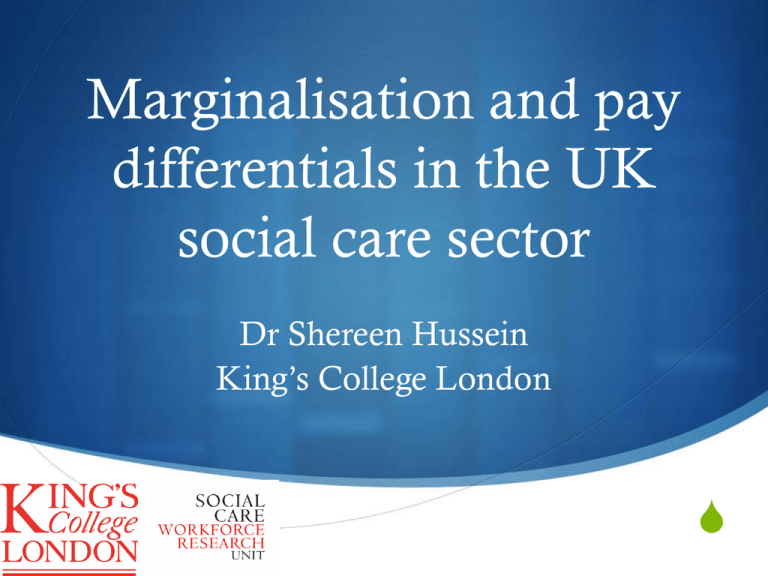Marginalisation and pay differentials in the UK social care sector
advertisement

Marginalisation and pay differentials in the UK social care sector Dr Shereen Hussein King’s College London S What is social care? S Social care supports people of all ages S With needs arising from physical, cognitive or disabilities S Assist in carrying out personal care or domestic routines (activities of daily living). S Helps sustain paid or unpaid work, education, learning, leisure and other social support systems. S Supports people in building social relationships and participating fully in society. 27/06/2012 2 shereen.hussein@kcl.ac.uk Why is social care so important? S Complex interactions of political, economical, sociological and demographic factors S Role of state, society and individuals S In the forefront of political debates S reforms, big society, mutuals, personalisation etc. S Value of emotional work S Duties and responsibilities S In the heart of demographic forces S Strong business case! 27/06/2012 3 shereen.hussein@kcl.ac.uk Formal and informal spheres of care S Sociology of care S Norms and traditions S Individual, society and government responsibilities S Working with other forms of support (social security, health and housing) S Complement, intersect but do not substitute one another S Interaction with health care 27/06/2012 4 shereen.hussein@kcl.ac.uk Marginalisation of the social care as a labour market sector S Dealing with a special kind of ‘commodity’ S Value of ‘care’ work to the society S Gendered; emotional; for granted ! S Responsibilities and duties of care S The role of the welfare state (means tested) S Assumed or planned S Pricing ‘emotional’ work 27/06/2012 5 shereen.hussein@kcl.ac.uk The position of the care sector and labour dynamics S S Secondary labour position S Migrants and BME workers contribution S S Domiciliary, residential S Individual budgets Pay and working conditions S Possible other rewards S Flexibility S Satisfaction S Stepping stone S Only job! S Temporarily or continuous 27/06/2012 Changing structure; place; nature, interaction with health services 6 S Links to government funds S Interactions with other markets S Role of the private and voluntary sector shereen.hussein@kcl.ac.uk Characteristics of the care sector S Means tested, state-funded, less than 12% of users S Private sector major supplier of services (75% of services) S Different types of settings- with domiciliary care workers accounting for 48% of the workforce S Increase policy emphasis on personalisation and user choice S Wages are a major cost component S Growing demand- high vacancy and turnover rates- almost a recession proof sector S No signs of funding reforms! 27/06/2012 7 shereen.hussein@kcl.ac.uk Workforce structure S Gender (80% women), age (mid 40s) and education (minimum skills required) S Migrants and immigration policies S International and local supply S Grey economy and domestic work S Lack/unclarity of career path S Marginalisation within a marginalised sector 27/06/2012 8 shereen.hussein@kcl.ac.uk Pay structure 27/06/2012 9 shereen.hussein@kcl.ac.uk Marginalisation in pay S One of the main low paying sectors (LPC) S S Before and after the introduction of the NMW Two tier pay levels; with direct care and ‘other’ workers paid on, below or just above the NMW S ‘Top’ tier includes professional workers (SW, OT ect.) and managers S Pay rates are significantly lower in the private sector and in domiciliary care settings S Ethnic pay-gaps also exist S S BME workers paid lower than white workers after accounting for other factors More people leave care work due to low pay from the private than statutory sector 27/06/2012 10 shereen.hussein@kcl.ac.uk Sector effect: hourly pay rate statistics for different job groups working in different sectors, SCWP 6 27/06/2012 11 shereen.hussein@kcl.ac.uk Setting effect: hourly pay rate statistics for different job groups working in different settings, SCWP 6 27/06/2012 12 shereen.hussein@kcl.ac.uk Investigating pay differentials in the sector S Using mixed-effect models S Controlling for measured and unobserved factors and cluster effects at different levels of hierarchy S Separate models for different job role groups S S S S 27/06/2012 Managers/supervisors Ancillary Direct care Professional 13 shereen.hussein@kcl.ac.uk Direct care workers pay differentials S Significant and large in magnitude effect of individual providers (55% of variance) S Sector variations are large and significant S Large regional effects S Significant fixed effects: S Type of care setting/service type S Ethnicity S Interactions between age and setting S Interactions between gender and setting S Interactions between sector and setting 27/06/2012 14 shereen.hussein@kcl.ac.uk Descriptive: Variations in hourly pay of adult direct care workers by some selected individual and employer-level characteristics, SCWP 7 27/06/2012 15 shereen.hussein@kcl.ac.uk Results of final mixed-effect model of hourly pay of adult direct care workers, SCWP 7 27/06/2012 16 shereen.hussein@kcl.ac.uk But .. Available data don’t represent accurate figures S Data provided by employers (NMDS-SC) S One figure for hourly rate (no indication of ‘enhanced’ rates etc.) S Sector is not very well defined (LFS) S Over represent higher wages and more stable workforce (ASHE) S Unrecorded ‘working’ time S Travel between clients S Extra work S On call – sleep in duties etc. 27/06/2012 17 shereen.hussein@kcl.ac.uk Attempt to improve estimates of those paid under NMW S Combining different data sources S Adjusting for unpaid travel time S Adopt a methodology that maximises the benefit of prior knowledge S Focus only on direct care workers (majority of the workforce) 27/06/2012 18 shereen.hussein@kcl.ac.uk Recent estimates and analysis S Approach S Sector specific data (provided by employers; NMDS-SC) adjusted by other sources (provided by workers; LoCS survey) S Accounting for previously published estimated by the LPC and small surveys (Bayesian approach) S Assumptions S Very small adjustments (average of 22.7 minutes of unpaid work and 4.8 min of travel time per week) S Findings S From (9.2% to 12.9%) or 156,673 to 219,241 ‘direct care’ workers in the UK are paid under the NMW 27/06/2012 19 shereen.hussein@kcl.ac.uk Pay distribution of direct care workers Source: Hussein (2011); SCWP Issue 16 27/06/2012 20 shereen.hussein@kcl.ac.uk Posterior distributions of being paid under the NMW 27/06/2012 21 shereen.hussein@kcl.ac.uk Risks- what to be aware of S Pay distributions are borderline with NMW in most cases S S S Any unpaid time likely to cause hourly pay rates to move under the NMW Any changes in the NMW rates will have a large impact Larger numbers of workers are likely to be affected if S S we include ‘other’ workers- 14% of the total workforce we include unreported work; especially through direct payment/personalisation schemes S Main risk areas for underpaying includes travel time/cost and night shifts S Innovative ways to cut costs: S 27/06/2012 reducing number of staff in shifts; increasing duties of lower paid ranks (care workers to give injections instead of nurses); shorter shifts (forcing some to work extra unpaid time); ‘real time’ shifts by the minutes etc. 22 shereen.hussein@kcl.ac.uk Marginalision Migrant workers 27/06/2012 23 shereen.hussein@kcl.ac.uk Migrant workers S Continue to constitute a considerable part of the workforce S S S S Majority non-EEA migrants (usually with nursing qualifications) Large regional variations Concentrated in certain jobs No large variations in pay levels S S S S Linked to immigration status- minimum wage> NMW Usually given ‘harder’ shifts which may pay more, e.g. night/weekend Discrimination Immigration policies: S Differences between EU and non-EU migrants S S S S 27/06/2012 Attachment to employer Qualifications Choice and mobility Language 24 shereen.hussein@kcl.ac.uk Experience of racism S Many experience racism and or discrimination S Then I noticed some of my colleagues started to, you know, I don’t know kind of my colleagues then so I think I noticed that, you know, people really sometimes they bully especially if you’re a different colour (Site 06, Migrant worker, Asian man 607). S Most are fine, but some clients can be rude and swear at you they can use racist comments: colour plays a big part. The excuse is often their mental health (Site 01, Migrant worker, black African woman 137). S Differential experiences of different ethnic groups S Visible social markers S Being ‘foreign’ S The ‘time’ factor 27/06/2012 Source: Stevens, Hussein and Manthorpe (2012) 25 shereen.hussein@kcl.ac.uk Top nationalities of migrant workers Source: Hussein (2011); SCWP Issue 11 27/06/2012 26 shereen.hussein@kcl.ac.uk 27/06/2012 27 shereen.hussein@kcl.ac.uk Trends of number of migrant workers (in the care sector) entering the social care sector from 1995-2010 by nationality groups 200 400 EEA 400 800 A8 75 150 N A2 4000 Non-EEA 2000 Source: Hussein (2011); SCWP 12 1995 2000 2005 2010 Year started in sector 27/06/2012 28 shereen.hussein@kcl.ac.uk Migrants and pay 27/06/2012 29 shereen.hussein@kcl.ac.uk 27/06/2012 30 shereen.hussein@kcl.ac.uk Another Advantage of many migrants “...are less likely to quibble and will accept worse conditions than established citizens; getting on with the job and not complaining too much.” (Refugee organisation director) Source: Hussein, Stevens and Manthorpe 2010 27/06/2012 31 shereen.hussein@kcl.ac.uk Next steps S Examine the profile of those likely to be paid under the NMW S Using sector specific data complemented by other national data S Sector differences S Type of settings S Providers/employers characteristics associated with very low pay S Investigate pay and conditions among workers employed directly by users (personal budgets) S Partnership/collaborative approach S Policy, research and practical knowledge S Understand, educate, regulate and penalise 27/06/2012 32 shereen.hussein@kcl.ac.uk References S Hussein, S., Manthorpe. J. and Stevens, M. (2011) The Experiences of Migrant Social Work and Social Care Practitioners in the UK: Findings from an Online Survey. European Journal of Social Work, 14(4): 479-496. S Hussein, S. (2011) ‘Estimating probabilities and numbers of direct care workers paid under the National Minimum Wage in the UK: A Bayesian approach. Social Care Workforce Periodical, Issue 16: December 2011’. S Hussein S. (2011) The contributions of migrants to the English care sector. Social Care Workforce Periodical, Issue 11- February 2011. S Hussein S. (2011) Migrant workers in long term care: evidence from England on trends, pay and profile. Social Care Workforce Periodical, Issue 12- March 2011. S Hussein S., Stevens M. and Manthorpe J. (2010) International Social Care Workers in England: Profile, Motivations, experiences and Future Expectations, February 2010. Final Report. S Stevens, M., Hussein, S. & Manthorpe, J., (2012), 'Experiences of racism and discrimination among migrant care workers in England: findings from a mixed-methods research project', Ethnicity and Racial Studies. 35(2): 259-280. 27/06/2012 33 shereen.hussein@kcl.ac.uk Thank You For Listening Now Your Turn! 27/06/2012 34 shereen.hussein@kcl.ac.uk






